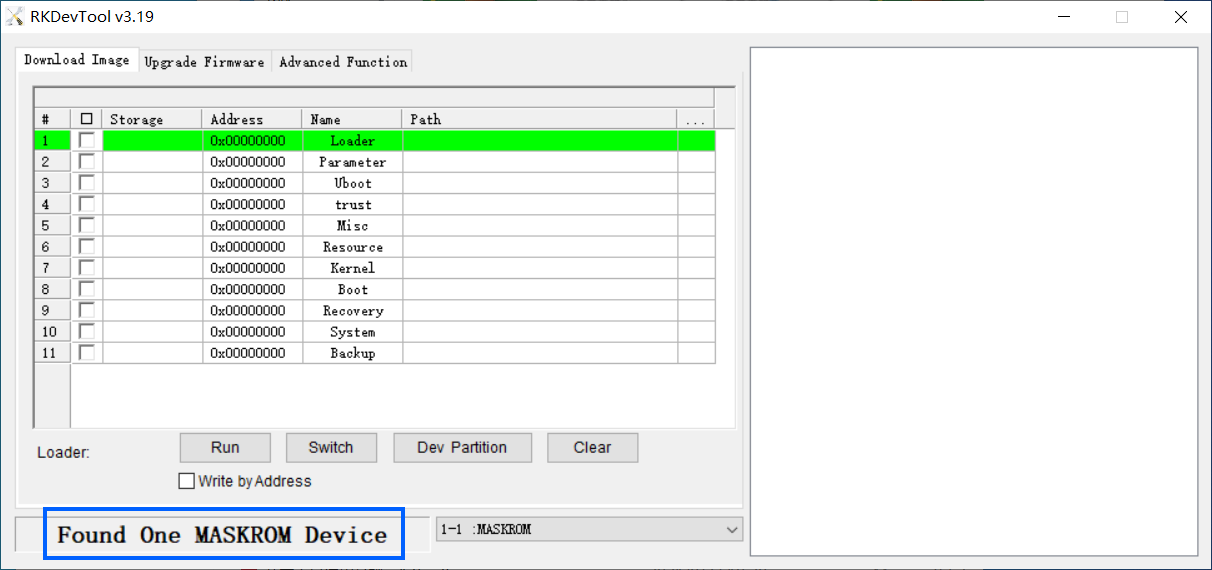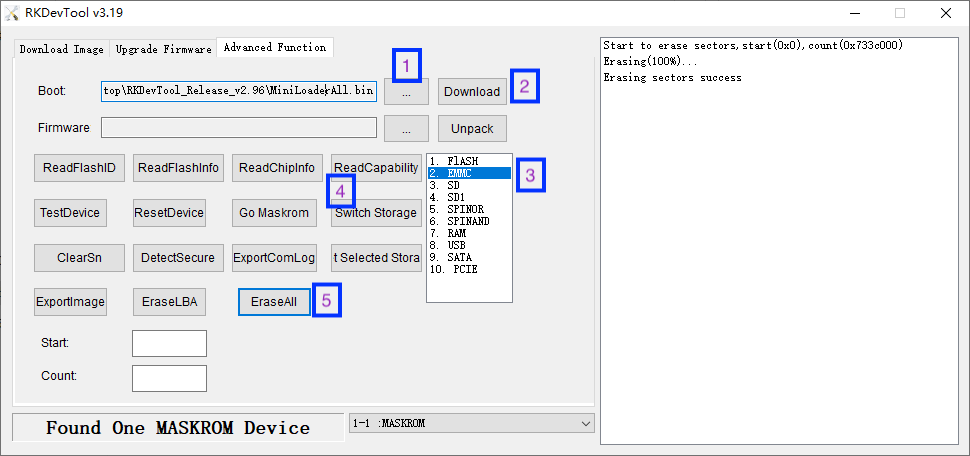|
|
| (92 intermediate revisions by the same user not shown) |
| Line 1: |
Line 1: |
| − | ===How to compile custom kernel and u-boot===
| |
| − | ====Kernel and u-boot versions for each OS====
| |
| − | {| class="wikitable"
| |
| − | |-
| |
| − | ! Operating System
| |
| − | ! Kernel Version
| |
| − | ! U-boot version
| |
| − | ! Cross-compiler
| |
| − | ! Partition type
| |
| − | ! Build toolset
| |
| − | ! Kernel code branch
| |
| − | ! Kernel configuration
| |
| − | ! U-boot code branch
| |
| − | ! u-boot configuration
| |
| − | |-
| |
| − | | buildroot
| |
| − | | rowspan="10" | linux v5.10.y
| |
| − | | rowspan="10" | u-boot <br />v2017.09
| |
| − | | rowspan="10" | 11.3-aarch64
| |
| − | | rowspan="10" | [https://github.com/friendlyarm/sd-fuse_rk3568/blob/master/prebuilt/parameter.template GPT]
| |
| − | | rowspan="10" | [https://github.com/friendlyarm/sd-fuse_rk3568/tree/master sd-fuse]
| |
| − | | rowspan="10" | [https://github.com/friendlyarm/kernel-rockchip/tree/nanopi5-v5.10.y_opt nanopi5-v5.10.y_opt]
| |
| − | | rowspan="6" | nanopi5_linux_defconfig
| |
| − | | rowspan="10" | [https://github.com/friendlyarm/uboot-rockchip/tree/nanopi5-v2017.09 nanopi5-v2017.09]
| |
| − | | rowspan="10" | rk3568_defconfig
| |
| − | |-
| |
| − | | friendlycore-focal-arm64
| |
| − | |-
| |
| − | | debian-bullseye-core-arm64
| |
| − | |-
| |
| − | | debian-bullseye-desktop-arm64
| |
| − | |-
| |
| − | | debian-bullseye-minimal-arm64
| |
| − | |-
| |
| − | | debian-buster-desktop-arm64
| |
| − | |-
| |
| − | | friendlywrt21
| |
| − | | rowspan="4" | nanopi5_linux_defconfig<br />friendlywrt.config
| |
| − | |-
| |
| − | | friendlywrt21-docker
| |
| − | |-
| |
| − | | friendlywrt22
| |
| − | |-
| |
| − | | friendlywrt22-docker
| |
| − | |}
| |
| − | * Kernel source code repository:https://github.com/friendlyarm/kernel-rockchip
| |
| − | * u-boot source code repository:https://github.com/friendlyarm/uboot-rockchip
| |
| − | * The cross-compile toolchain is located in the path: /opt/FriendlyARM/toolchain/. Using the toolchain is as simple as adding the toolchain’s bin directory in your PATH, such as:
| |
| − | <syntaxhighlight lang="bash">
| |
| − | export PATH=/opt/FriendlyARM/toolchain/11.3-aarch64/bin/:$PATH
| |
| − | </syntaxhighlight>
| |
| − | * The [https://github.com/friendlyarm/sd-fuse_rk3568/tree/master sd-fuse] build toolset can be used to quickly compile the kernel and u-boot, as well as repackaging SD card image and SD-to-eMMC image.
| |
| − | ====Compile kernel linux-v5.10.y====
| |
| − | Download the source code and compile as follows:
| |
| − | <syntaxhighlight lang="bash">
| |
| − | git clone https://github.com/friendlyarm/kernel-rockchip --single-branch --depth 1 -b nanopi5-v5.10.y_opt kernel-rockchip
| |
| − | cd kernel-rockchip
| |
| − | export PATH=/opt/FriendlyARM/toolchain/11.3-aarch64/bin/:$PATH
| |
| − | touch .scmversion
| |
| − | # Configuring the Kernel
| |
| − | # Option1: Load Linux system configuration
| |
| − | make CROSS_COMPILE=aarch64-linux-gnu- ARCH=arm64 nanopi5_linux_defconfig
| |
| − | # Option2: Load FriendlyWrt system configuration
| |
| − | # make CROSS_COMPILE=aarch64-linux-gnu- ARCH=arm64 nanopi5_linux_defconfig friendlywrt.config
| |
| − | # Launch configuration interface
| |
| − | # make CROSS_COMPILE=aarch64-linux-gnu- ARCH=arm64 menuconfig
| |
| − | # Compiling Kernel
| |
| − | make CROSS_COMPILE=aarch64-linux-gnu- ARCH=arm64 nanopi5-images -j$(nproc)
| |
| − | # Compiling the driver modules
| |
| − | mkdir -p out-modules && rm -rf out-modules/*
| |
| − | make CROSS_COMPILE=aarch64-linux-gnu- ARCH=arm64 INSTALL_MOD_PATH="$PWD/out-modules" modules -j$(nproc)
| |
| − | make CROSS_COMPILE=aarch64-linux-gnu- ARCH=arm64 INSTALL_MOD_PATH="$PWD/out-modules" modules_install
| |
| − | KERNEL_VER=$(make CROSS_COMPILE=aarch64-linux-gnu- ARCH=arm64 kernelrelease)
| |
| − | [ ! -f "$PWD/out-modules/lib/modules/${KERNEL_VER}/modules.dep" ] && depmod -b $PWD/out-modules -E Module.symvers -F System.map -w ${KERNEL_VER}
| |
| − | (cd $PWD/out-modules && find . -name \*.ko | xargs aarch64-linux-strip --strip-unneeded)
| |
| − | </syntaxhighlight>
| |
| − | You will get the following file:
| |
| − | {| class="wikitable"
| |
| − | |-
| |
| − | | kernel.img
| |
| − | | resource.img
| |
| − | | <del>boot.img This img is deprecated</del>
| |
| − | | The kernel modules are located in the out-modules directory
| |
| − | |}
| |
| − | Installing the kernel: <br>
| |
| − | Please click on [[#Download u-boot and the kernel to the target board]]<br>
| |
| − | ====Compile u-boot v2017.09====
| |
| − | Download the source code and compile as follows:
| |
| − | <syntaxhighlight lang="bash">
| |
| − | git clone https://github.com/friendlyarm/rkbin --single-branch --depth 1 -b nanopi5
| |
| − | git clone https://github.com/friendlyarm/uboot-rockchip --single-branch --depth 1 -b nanopi5-v2017.09
| |
| − | export PATH=/opt/FriendlyARM/toolchain/11.3-aarch64/bin/:$PATH
| |
| − | cd uboot-rockchip/
| |
| − | ./make.sh nanopi5
| |
| − | </syntaxhighlight>
| |
| − | After the compilation, the following files will be generated:
| |
| − | {| class="wikitable"
| |
| − | |-
| |
| − | | uboot.img
| |
| − | | rk356x_spl_loader_v1.15.112.bin (Before packaging, you need to rename it to MiniLoaderAll.bin)
| |
| − | |}
| |
| − | Installing the u-boot: <br>
| |
| − | Please click on [[#Download u-boot and the kernel to the target board]]<br>
| |
| | | | |
| − | ====Download u-boot and the kernel to the target board====
| + | {{RockchipUnbrick|NanoPC-T4}} |
| − | =====Download to the installed system=====
| + | |
| − | Since the RK3568's OS uses GPT partitions by default, you can use the dd command to write the image file to the partition, the device nodes for SD card and eMMC are shown below:
| + | |
| − | * The SD/TF Card device node: /dev/mmcblk0 <br />
| + | |
| − | * The eMMC device node: /dev/mmcblk2 <br />
| + | |
| − | The following is an example of how to update the kernel to eMMC:<br />
| + | |
| − | Use the 'parted' command to view the partition layout:
| + | |
| − | <syntaxhighlight lang="bash">
| + | |
| − | parted /dev/mmcblk2 print
| + | |
| − | </syntaxhighlight>
| + | |
| − | You should get output similar to the following:
| + | |
| − | <syntaxhighlight lang="bash">
| + | |
| − | Model: MMC A3A551 (sd/mmc)
| + | |
| − | Disk /dev/mmcblk2: 31.0GB
| + | |
| − | Sector size (logical/physical): 512B/512B
| + | |
| − | Partition Table: gpt
| + | |
| − | Disk Flags:
| + | |
| − | | + | |
| − | Number Start End Size File system Name Flags
| + | |
| − | 1 8389kB 12.6MB 4194kB uboot
| + | |
| − | 2 12.6MB 16.8MB 4194kB misc
| + | |
| − | 3 16.8MB 21.0MB 4194kB dtbo
| + | |
| − | 4 21.0MB 37.7MB 16.8MB resource
| + | |
| − | 5 37.7MB 79.7MB 41.9MB kernel
| + | |
| − | 6 79.7MB 113MB 33.6MB boot
| + | |
| − | 7 113MB 147MB 33.6MB recovery
| + | |
| − | 8 147MB 31.0GB 30.9GB ext4 rootfs
| + | |
| − | </syntaxhighlight>
| + | |
| − | as shown above, the resource partition is located at 4 and the kernel partition is located at 5. Use the dd command to write the resource.img and kernel.img files to these partitions, the commands are as follows:
| + | |
| − | <syntaxhighlight lang="bash">
| + | |
| − | dd if=resource.img of=/dev/mmcblk2p4 bs=1M
| + | |
| − | dd if=kernel.img of=/dev/mmcblk2p5 bs=1M
| + | |
| − | </syntaxhighlight>
| + | |
| − | If you want to update u-boot:
| + | |
| − | <syntaxhighlight lang="bash">
| + | |
| − | dd if=boot.img of=/dev/mmcblk2p1 bs=1M
| + | |
| − | </syntaxhighlight>
| + | |
| − | To update new driver modules, copy the newly compiled driver modules to the appropriate directory under /lib/modules.
| + | |
| − | | + | |
| − | =====How to create a new OS image file=====
| + | |
| − | To create a new OS image file, you need to use the "sd-fuse" packaging tool.<br />
| + | |
| − | <br />
| + | |
| − | "sd-fuse" is a collection of scripts that can be used to create bootable SD card images for FriendlyElec boards. Its main features include:<br />
| + | |
| − | * Creation of root filesystem images from a directory <br />
| + | |
| − | * Building of bootable SD card images<br />
| + | |
| − | * Simple compilation of kernel, U-Boot, and third-party drivers<br />
| + | |
| − | Please click on the following link to find out more:
| + | |
| − | {| class="wikitable" | + | |
| − | |-
| + | |
| − | ! Kernel version
| + | |
| − | ! Build toolset
| + | |
| − | |-
| + | |
| − | | linux v5.10.y
| + | |
| − | | [https://github.com/friendlyarm/sd-fuse_rk3568/tree/master<br /> sd-fuse_rk3568]
| + | |
| − | |}
| + | |
| − | =====USB flashing=====
| + | |
| − | ======Linux======
| + | |
| − | To flash U-Boot and kernel using the "upgrade_tool" tool, please use the following command:
| + | |
| − | <syntaxhighlight lang="bash">
| + | |
| − | sudo upgrade_tool ul MiniLoaderAll.bin
| + | |
| − | sudo upgrade_tool di -p parameter.txt
| + | |
| − | sudo upgrade_tool di uboot uboot.img
| + | |
| − | sudo upgrade_tool di resource resource.img
| + | |
| − | sudo upgrade_tool di kernel kernel.img
| + | |
| − | sudo upgrade_tool RD
| + | |
| − | </syntaxhighlight>
| + | |
| − | Note: "upgrade_tool" is a command-line tool provided by Rockchip for Linux operating systems (Linux_Upgrade_Tool).
| + | |
If the ROM is not installed correctly, causing the development board to become bricked, and you might not have the opportunity to reinstall the ROM via an SD card, you need to enter Maskrom mode to unbrick it by erasing the storage device.
The following commands are for Linux, with only slight differences in file and directory names for Mac users:
A result similar to "DevNo=1 Vid=0x2207,Pid=0x350b,LocationID=13 Mode=Maskrom SerialNo=" indicates that the device has been detected.

